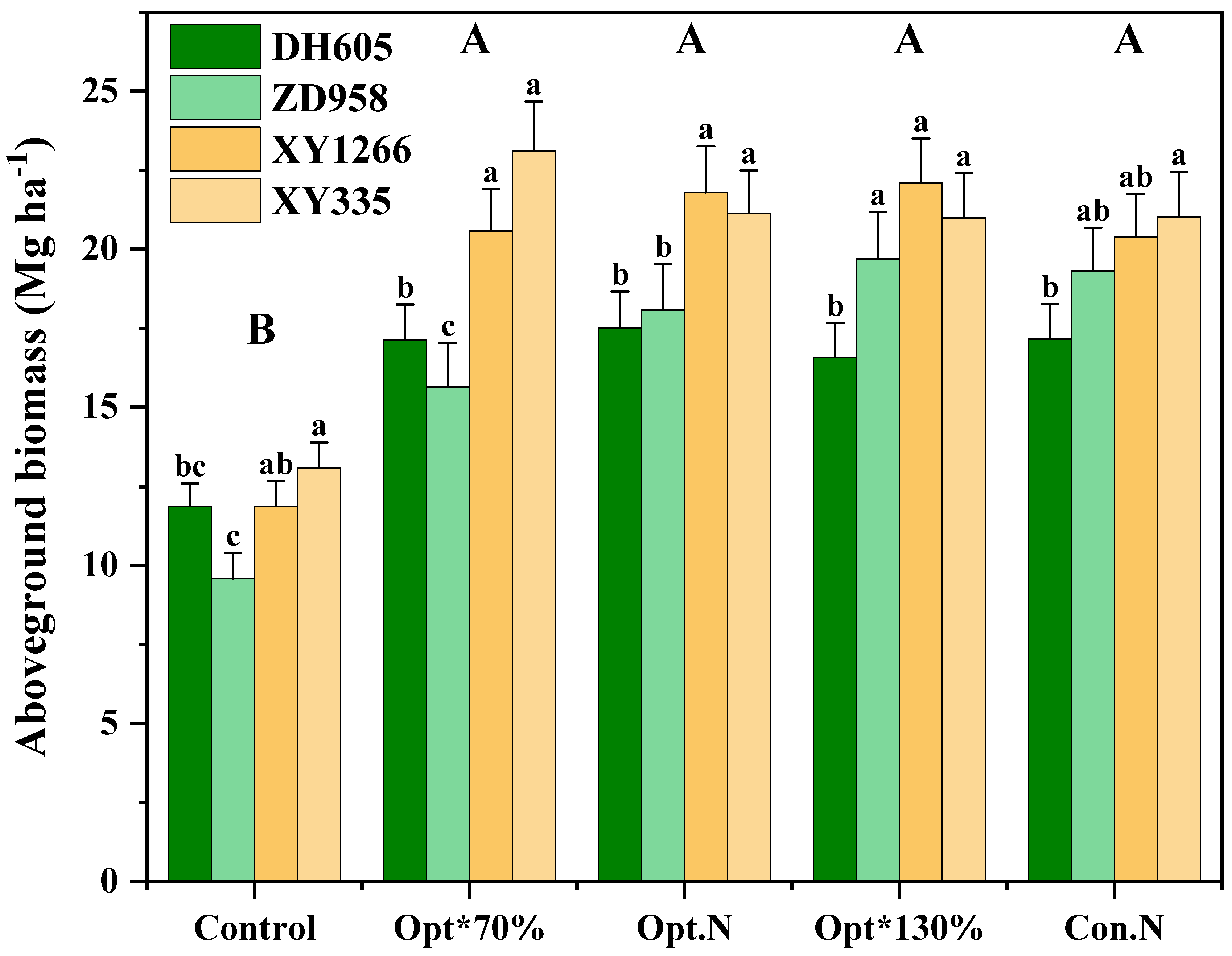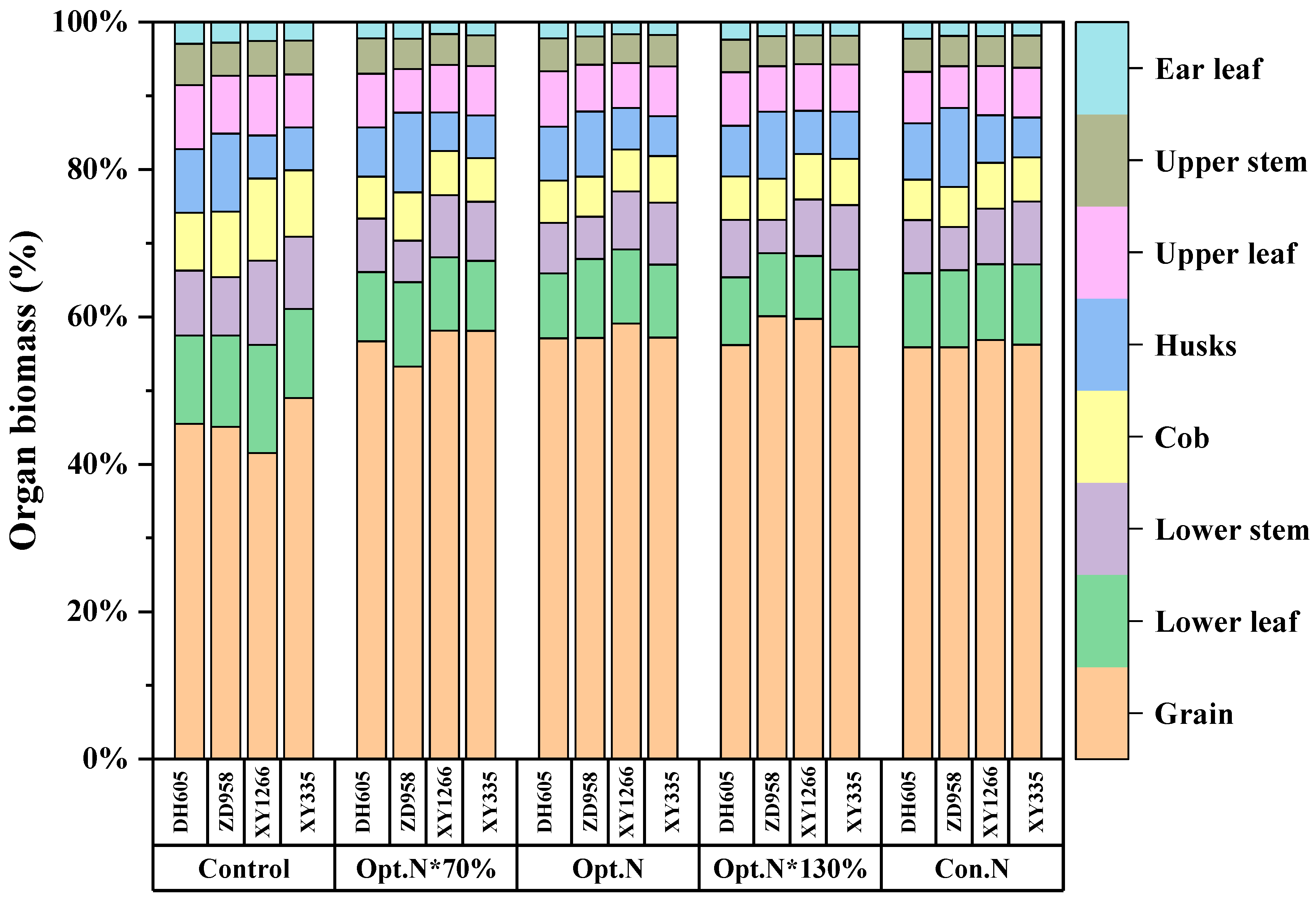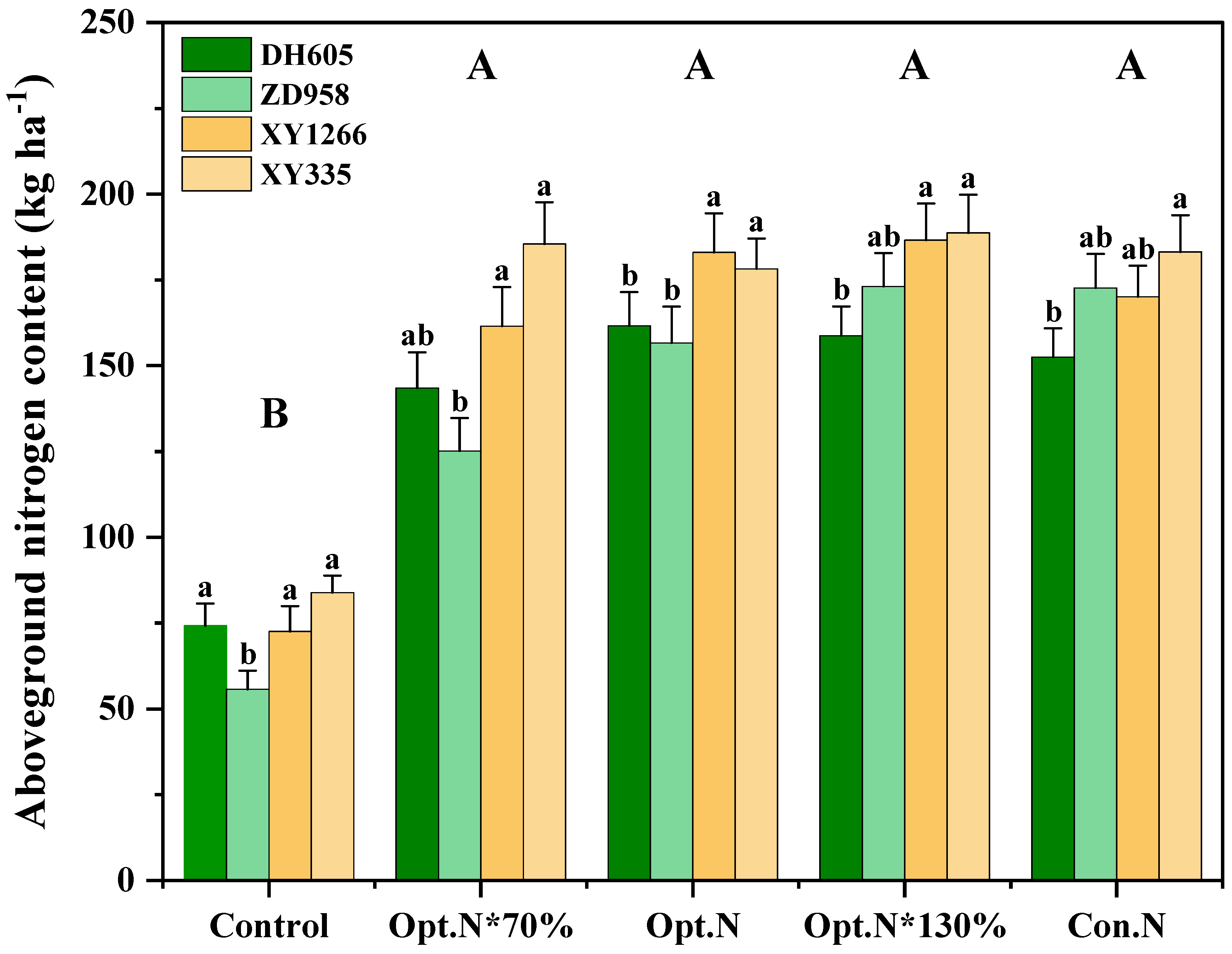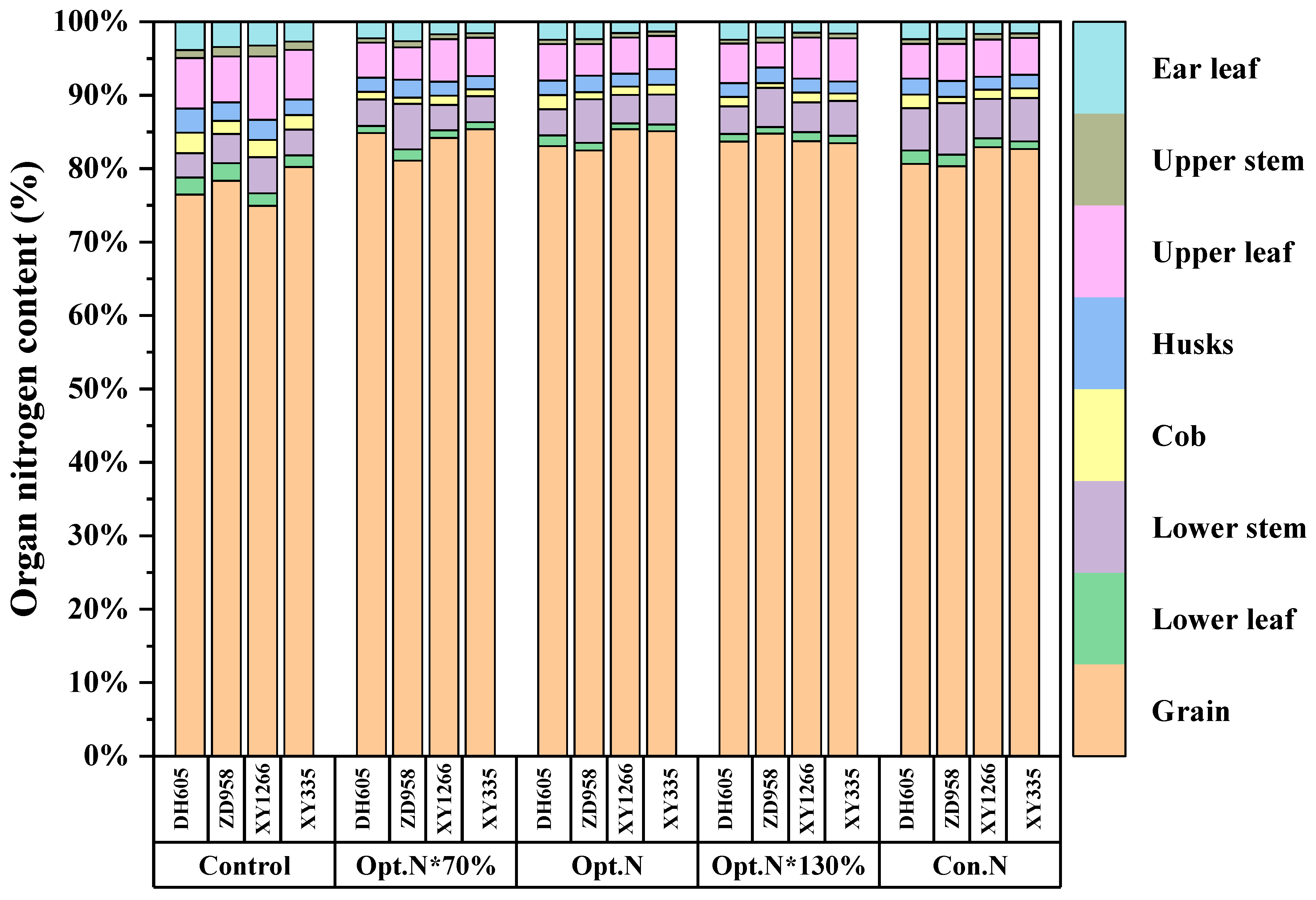Integrated Moderate Stay-Green Hybrids and Optimal Nitrogen Management Improving Maize Productivity and Grain Nitrogen Uptake
Abstract
1. Introduction
2. Materials and Methods
2.1. Experimental Site
2.2. Experimental Design
2.3. Sampling and Laboratory Procedures
2.4. Statistical Analysis
3. Results
3.1. Grain Yield and Yield Components
3.2. Biomass Accumulation and Distribution
3.3. Nitrogen Concentration in Different Organs of Maize
3.4. Aboveground N Content and N Allocation
4. Discussion
4.1. Effect of N Management on Yield and Yield Components of Different Stay-Green Types
4.2. Effects of N Application on Aboveground Biomass and Distribution of Different Stay-Green Types of Maize
4.3. N Uptake and Allocation of Maize with Different Stay-Green Types Under Different N Management Treatments
5. Conclusions
Supplementary Materials
Author Contributions
Funding
Data Availability Statement
Conflicts of Interest
References
- National Bureau of Statistics of China. China Statistical Yearbook 2024; National Bureau of Statistics of China: Beijing, China, 2024; pp. 4–5. ISBN 978-7-5230-0486-9. [Google Scholar]
- Hu, Y.Y.; Zhu, Y.X.; Yang, Y.H.; Zou, J.; Chen, F.; Yin, X. Changes of the planting structure of major food oil crops in China from 1951 to 2015. J. China Agric. Univ. 2019, 24, 183–196. [Google Scholar] [CrossRef]
- Liu, X.; Zhang, Y.; Han, W.; Tang, A.; Shen, J.; Cui, Z.; Vitousek, P.; Erisman, J.W.; Goulding, K.; Christie, P.; et al. Enhanced nitrogen deposition over China. Nature 2013, 494, 459–462. [Google Scholar] [CrossRef] [PubMed]
- Guo, J.H.; Liu, X.J.; Zhang, Y.; Shen, J.L.; Han, W.X.; Zhang, W.F.; Christie, P.; Goulding, K.W.T.; Vitousek, P.M.; Zhang, F.S. Significant acidification in major Chinese croplands. Science 2010, 327, 1008–1010. [Google Scholar] [CrossRef] [PubMed]
- Sun, Z.; Yang, R.L.; Wang, J.; Zhou, P.; Gong, Y.; Gao, F.; Wang, C. Effects of nutrient deficiency on crop yield and soil nutrients under winter wheat–summer maize rotation system in the North China Plain. Agronomy 2024, 14, 2690. [Google Scholar] [CrossRef]
- Su, W.N.; Kamran, M.; Xie, J.; Meng, X.; Han, Q.; Liu, T.; Han, J. Shoot and root traits of summer maize hybrid varieties with higher grain yields and higher nitrogen use efficiency at low nitrogen application rates. PeerJ 2019, 7, e7294. [Google Scholar] [CrossRef]
- Cardwell, V.B. Fifty years of minnesota corn production: Sources of yield increase. Agron. J. 1982, 74, 984–990. [Google Scholar] [CrossRef]
- Khush, G.S. Green revolution: Preparing for the 21st century. Genome 1999, 42, 646–655. [Google Scholar] [CrossRef]
- Tollenaar, M.; Lee, E.A. Yield potential, yield stability and stress tolerance in maize. Field Crop Res. 2002, 75, 161–169. [Google Scholar] [CrossRef]
- Duvick, D.N. The contribution of breeding to yield advances in maize (Zea mays L.). Adv. Agron. 2005, 86, 83–145. [Google Scholar]
- Lv, M.; Huang, M.; Zhao, K.N.; Gu, X.; Li, S.; Wang, J.; Yin, F.; Liu, L.; Jiao, N.; Fu, G. Effects of partial substitution of organic fertilizer for synthetic n fertilizer on yield and n use efficiencies in a semiarid winter wheat–summer maize rotation. Agronomy 2023, 13, 2281. [Google Scholar] [CrossRef]
- Ma, R.S.; Jiang, C.Z.; Shou, N.; Gao, W.; Yang, X. An optimized nitrogen application rate and basal topdressing ratio improves yield, quality, and water- and n-use efficiencies for forage maize (Zea mays L.). Agronomy 2023, 13, 181. [Google Scholar] [CrossRef]
- Ciampitti, I.A.; Vyn, T.J. Grain nitrogen source changes over time in maize: A review. Crop Sci. 2013, 53, 366–377. [Google Scholar] [CrossRef]
- Lei, H.; Zhou, F.; Cai, Q.Y.; Wang, X.; Du, L.; Lan, T.; Kong, F.; Yuan, J. Effects of planting density and nitrogen management on light and nitrogen resource utilization efficiency and yield of summer maize in the Sichuan hilly region. Agronomy 2024, 14, 1470. [Google Scholar] [CrossRef]
- Hirel, B.; Le Gouis, J.; Ney, B.; Gallais, A. The challenge of improving nitrogen use efficiency in crop plants: Towards a more central role for genetic variability and quantitative genetics within integrated approaches. J. Exp. Bot. 2007, 58, 2369–2387. [Google Scholar] [CrossRef] [PubMed]
- White, A.C.; Rogers, A.; Rees, M.; Osborne, C.P. How can we make plants grow faster? A source–sink perspective on growth rate. J. Exp. Bot. 2016, 67, 31–45. [Google Scholar] [CrossRef] [PubMed]
- Du, K.; Zhao, W.Q.; Lv, Z.W.; Xu, B.; Hu, W.; Zhou, Z.; Wang, Y. Optimal rate of nitrogen fertilizer improves maize grain yield by delaying the senescence of ear leaves and thereby altering their nitrogen remobilization. Field Crop Res. 2024, 310, 109359. [Google Scholar] [CrossRef]
- Ning, P.; Fritschi, F.B.; Li, C.J. Temporal dynamics of post-silking nitrogen fluxes and their effects on grain yield in maize under low to high nitrogen inputs. Field Crop Res. 2017, 204, 249–259. [Google Scholar] [CrossRef]
- Pommel, B.; Gallais, A.; Coque, M.; Quilleré, I.; Hirel, B.; Prioul, J.L.; Andrieu, B.; Floriot, M. Carbon and nitrogen allocation and grain filling in three maize hybrids differing in leaf senescence. Eur. J. Agron. 2006, 24, 203–211. [Google Scholar] [CrossRef]
- Chen, K.R.; Vyn, T.J. Post-silking factor consequences for N efficiency changes over 38 years of commercial maize hybrids. Front. Plant Sci. 2017, 8, 1737. [Google Scholar] [CrossRef]
- Guo, S. Mechanism of Nitrogen Remobilization Efficiency in Chinese Maize Hybrids Affected by Stay-Green. Ph.D. Thesis, China Agricultural University, Beijing, China, 2015. [Google Scholar]
- Shao, H.; Shi, D.F.; Shi, W.J.; Ban, X.; Chen, Y.; Ren, W.; Chen, F.; Mi, G. Nutrient accumulation and remobilization in relation to yield formation at high planting density in maize hybrids with different senescent characters. Arch. Agron. Soil Sci. 2021, 67, 487–503. [Google Scholar] [CrossRef]
- Zhang, L.; Liang, Z.Y.; He, X.M.; Meng, Q.F.; Hu, Y.C.; Schmidhalter, U.; Zhang, W.; Zou, C.Q.; Chen, X.P. Improving grain yield and protein concentration of maize (Zea mays L.) simultaneously by appropriate hybrid selection and nitrogen management. Field Crop Res. 2020, 249, 107754. [Google Scholar] [CrossRef]
- Chen, X.P.; Cui, Z.L.; Vitousek, P.M.; Cassman, K.G.; Matson, P.A.; Bai, J.-S.; Meng, Q.-F.; Hou, P.; Yue, S.-C.; Römheld, V.; et al. Integrated soil–crop system management for food security. Proc. Natl. Acad. Sci. USA 2011, 108, 6399–6404. [Google Scholar] [CrossRef] [PubMed]
- Zhang, S.S.; Yue, S.C.; Yan, P.; Qiu, M.; Chen, X.; Cui, Z. Testing the suitability of the end-of-season stalk nitrate test for summer corn (Zea mays L.) production in China. Field Crop Res. 2013, 154, 153–157. [Google Scholar] [CrossRef]
- Tian, G.; Ren, W.; Xu, J.P.; Liu, X.; Liang, J.; Mi, G.; Gong, X.; Chen, F. Microbiology combined with the root metabolome reveals the responses of root microorganisms to maize cultivars under different forms of nitrogen supply. Agronomy 2024, 14, 1828. [Google Scholar] [CrossRef]
- Ren, B.Z.; Li, L.L.; Dong, S.T.; Liu, P.; Zhao, B.; Zhang, J.W. Photosynthetic characteristics of summer maize hybrids with different plant heights. Agron. J. 2017, 109, 1454–1462. [Google Scholar] [CrossRef]
- Horowitz, R.S. Teaching mathematics to students with learning disabilities. Interv. Sch. Clin. 1970, 6, 17–35. [Google Scholar] [CrossRef]
- Zhang, L.L.; Zhou, X.L.; Fan, Y.; Fu, J.; Hou, P.; Yang, H.L.; Qi, H. Post-silking nitrogen accumulation and remobilization are associated with green leaf persistence and plant density in maize. J. Integr. Agric. 2019, 18, 1882–1892. [Google Scholar] [CrossRef]
- Kosgey, J.R.; Moot, D.J.; Fletcher, A.L.; McKenzie, B.A. Dry matter accumulation and post-silking N economy of ‘stay-green’ maize (Zea mays L.) hybrids. Eur. J. Agron. 2013, 51, 43–52. [Google Scholar] [CrossRef]
- Cui, Z.l.; Yue, S.C.; Wang, G.L.; Meng, Q.; Wu, L.; Yang, Z.; Zhang, Q.; Li, S.; Zhang, F.; Chen, X. Closing the yield gap could reduce projected greenhouse gas emissions: A case study of maize production inChina. Glob. Chang Biol. 2013, 19, 2467–2477. [Google Scholar] [CrossRef]
- Noor, M.A. Dry Matter and Nitrogen Partitioning for High–Yielding Maize Hybrids Under Different Planting Densities and Nitrogen Rates and Their Interplay. Ph.D. Thesis, Chinese Academy of Agricultural Sciences, Beijing, China, 2019. [Google Scholar]
- Liu, J.; Yuan, J.; Cai, H.; Ren, J.; Liang, Y.; Hou, W.; Chen, G. Accumulation and partition of dry mass and nitrogen in three maize (Zea mays L.) hybrids grown under five planting densities. Appl. Ecol. Environ. Res. 2020, 18, 5683–5699. [Google Scholar] [CrossRef]
- Wang, Z.G.; Ma, B.L.; Yu, X.F.; Gao, J.; Sun, J.; Su, Z.; Yu, S. Physiological basis of heterosis for nitrogen use efficiency of maize. Sci. Rep. 2019, 9, 18708. [Google Scholar] [CrossRef] [PubMed]
- Messina, C.; McDonald, D.; Poffenbarger, H.; Clark, R.; Salinas, A.; Fang, Y.; Gho, C.; Tang, T.; Graham, G.; Hammer, G.L.; et al. Reproductive resilience but not root architecture underpins yield improvement under drought in maize. J. Exp. Bot. 2021, 72, 5235–5245. [Google Scholar] [CrossRef]
- Fernandez, J.A.; Messina, C.D.; Rotundo, J.L.; Ciampitti, I.A. Integrating nitrogen and water-soluble carbohydrates dynamics in maize: A comparison of hybrids from different decades. Crop Sci. 2021, 61, 1360–1373. [Google Scholar] [CrossRef]
- Shen, L.X.; Wang, P.; Lan, L.W.; Sun, X.H. Effect of nitrogen supply on carbon-nitrogen metabolism and kernel set in summer maize. Plant Nutr. Fertil. Sci. 2007, 13, 1074–1079. [Google Scholar]
- Tollenaar, M. Physiological basis of genetic improvement of maize hybrids in Ontario from 1959 to 1988. Crop Sci. 1991, 31, 119–124. [Google Scholar] [CrossRef]
- Xu, X.P.; He, P.; Pampolino, M.F.; Chuan, L.; Johnston, A.M.; Qiu, S.; Zhao, S.; Zhou, W. Nutrient requirements for maize in China based on QUEFTS analysis. Field Crop Res. 2013, 150, 115–125. [Google Scholar] [CrossRef]
- Pagani, A.; Echeverría, H.E.; Andrade, F.H.; Sainz Rozas, H.R. Effects of nitrogen and sulfur application on grain yield, nutrient accumulation, and harvest indexes in maize. J. Plant Nutr. 2012, 35, 1080–1097. [Google Scholar] [CrossRef]
- Zhai, J.; Zhang, G.Q.; Zhang, Y.M.; Xu, W.; Xie, R.; Ming, B.; Hou, P.; Wang, K.; Xue, J.; Li, S. Effect of the rate of nitrogen application on dry matter accumulation and yield formation of densely planted maize. Sustainability 2022, 14, 14940. [Google Scholar] [CrossRef]
- Chen, X.C.; Chen, F.J.; Chen, Y.L.; Gao, Q.; Yang, X.; Yuan, L.; Zhang, F.; Mi, G. Modern maize hybrids in Northeast China exhibit increased yield potential and resource use efficiency despite adverse climate change. Glob. Change Biol. 2012, 19, 923–936. [Google Scholar] [CrossRef]
- Duvick, D.N.; Cassman, K.G. Post–green revolution trends in yield potential of temperate maize in the north-central united states. Crop Sci. 1999, 39, 1622–1630. [Google Scholar] [CrossRef]
- Liu, P.Z.; Zhou, D.; Guo, X.Y.; Yu, Q.; Zhang, Y.H.; Li, H.Y.; Zhang, Q.; Wang, X.M.; Wang, X.L.; Wang, R.; et al. Response of water use and yield of dryland winter wheat to nitrogen application under different rainfall patterns. Sci. Agric. Sin. 2021, 54, 3065–3076. [Google Scholar] [CrossRef]
- Deng, L.J.; Jiao, X.Q. A meta-analysis of effects of nitrogen management on winter wheat yield and quality. Sci. Agric. Sin. 2021, 54, 2355–2365. [Google Scholar] [CrossRef]




| Treatment | Total Nitrogen Rate (kg ha−1) | Pre-Sowing (kg ha−1) | V6 Stage (kg ha−1) | VT Stage (kg ha−1) |
|---|---|---|---|---|
| Control | 0 | 0 | 0 | 0 |
| Opt.N*70% | 103.6 | 31.5 | 51.1 | 21.0 |
| Opt.N | 148 | 45.0 | 73.0 | 30.0 |
| Opt.N*130% | 192.4 | 58.5 | 94.9 | 39.0 |
| Con.N | 250 | 100 | 150 | 0.0 |
| Treatment | Hybrid | Grain Yield (Mg ha−1) | Grain Rows per Ear | Grains per Row | Grains per Ear | 1000-Grain Weight (g) | Harvest Index |
|---|---|---|---|---|---|---|---|
| Control | DH605 | 5.41 ab B | 13.5 a B | 18.4 a B | 248 a B | 276 ab A | 0.46 ab B |
| ZD958 | 4.33 c | 13.3 a | 15.8 b | 211 b | 262 b | 0.45 ab | |
| XY1266 | 4.93 bc | 12.4 ab | 16.6 ab | 206 b | 280 a | 0.42 b | |
| XY335 | 6.41 a | 11.8 b | 18.7 a | 222 ab | 286 a | 0.49 a | |
| Opt.N*70% | DH605 | 9.63 b A | 16.0 a A | 25.7 c A | 411 b A | 281 b A | 0.57 a A |
| ZD958 | 8.56 c | 14.5 a | 26.2 c | 380 c | 263 c | 0.53 b | |
| XY1266 | 12.2 a | 14.7 a | 31.9 a | 468 a | 294 a | 0.58 a | |
| XY335 | 13.3 a | 14.7 a | 29.6 b | 435 ab | 313 a | 0.58 a | |
| Opt.N | DH605 | 11.2 b A | 15.7 a A | 27.8 c A | 435 b A | 290 a A | 0.59 a A |
| ZD958 | 10.3 b | 14.7 a | 26.2 c | 386 c | 290 a | 0.57 a | |
| XY1266 | 12.9 a | 15.1 a | 33.9 a | 511 a | 285 a | 0.59 a | |
| XY335 | 12.1 a | 14.4 a | 31.4 b | 453 ab | 293 a | 0.57 a | |
| Opt.N*130% | DH605 | 9.32 b A | 15.2 a A | 26.2 c A | 398 c A | 302 a A | 0.56 b A |
| ZD958 | 11.8 a | 14.6 b | 29.8 b | 434 b | 270 b | 0.60 a | |
| XY1266 | 13.2 a | 16.3 a | 32.8 a | 536 a | 279 ab | 0.60 a | |
| XY335 | 11.8 a | 15.0 ab | 29.0 bc | 435 b | 308 a | 0.56 b | |
| Con.N | DH605 | 9.68 b A | 16.1 a A | 23.3 c A | 374 c A | 277 a A | 0.56 a A |
| ZD958 | 10.5 ab | 15.4 a | 27.9 b | 430 b | 282 a | 0.57 a | |
| XY1266 | 11.4 ab | 15.3 a | 31.8 a | 486 a | 276 a | 0.57 a | |
| XY335 | 11.8 a | 14.8 a | 29.4 ab | 436 ab | 306 a | 0.56 a | |
| Variance analysis ANOVA | |||||||
| Hybrid (H) | * | * | ** | * | NS | NS | |
| Fertilizer Amount (F) | ** | ** | ** | ** | NS | * | |
| H × F | * | NS | * | * | NS | NS | |
| Treatment | Hybrid | g kg−1 | |||||||
|---|---|---|---|---|---|---|---|---|---|
| Grain | Cob | Husks | Ear Leaf | Upper Leaf | Lower Leaf | Upper Stem | Lower Stem | ||
| Control | DH605 | 10.6 a C | 2.03 a A | 3.71 a B | 8.25 a A | 4.93 a B | 1.68 ab A | 0.87 a B | 1.75 a C |
| ZD958 | 10.2 a | 1.34 c | 3.26 a | 7.23 a | 4.65 a | 1.34 b | 0.85 a | 1.89 a | |
| XY1266 | 11.2 a | 1.80 ab | 3.64 a | 7.74 a | 4.67 a | 1.80 a | 0.84 a | 2.08 a | |
| XY335 | 10.6 a | 1.77 b | 2.99 a | 6.93 a | 4.47 a | 1.77 ab | 0.81 a | 1.90 a | |
| Opt.N*70% | DH605 | 12.6 a B | 1.20 a A | 3.37 b A | 8.53 a A | 5.52 a A | 1.20 a A | 0.87 a AB | 3.25 b BC |
| ZD958 | 12.3 a | 1.18 a | 4.71 a | 9.31 a | 6.36 a | 1.18 a | 1.04 a | 4.35 a | |
| XY1266 | 11.4 a | 1.54 a | 3.60 ab | 8.14 a | 5.41 a | 1.54 a | 0.90 a | 2.73 b | |
| XY335 | 11.8 a | 1.10 a | 3.52 b | 6.93 ab | 5.21 a | 1.37 a | 0.85 a | 3.00 b | |
| Opt.N | DH605 | 13.5 a AB | 2.37 a A | 4.10 b A | 10.2 a A | 6.77 a A | 1.84 a A | 0.96 ab AB | 3.76 b AB |
| ZD958 | 12.6 a | 1.31 c | 5.16 a | 10.5 a | 6.52 a | 1.05 b | 1.07 a | 4.84 a | |
| XY1266 | 12.2 a | 1.57 bc | 3.77 b | 7.70 b | 5.30 b | 1.19 ab | 0.93 ab | 3.25 b | |
| XY335 | 12.6 a | 1.69 ab | 4.19 ab | 6.35 b | 4.57 b | 1.41 ab | 0.82 b | 3.51 b | |
| Opt.N*130% | DH605 | 14.3 a A | 1.69 a A | 4.18 ab A | 9.75 a A | 6.60 a A | 1.44 a A | 0.90 a A | 3.95 b A |
| ZD958 | 12.5 b | 0.92 b | 4.62 a | 9.93 a | 6.59 a | 0.86 b | 1.08 a | 5.52 a | |
| XY1266 | 11.9 b | 1.78 a | 4.18 ab | 6.97 a | 6.17 a | 1.78 ab | 0.93 a | 4.04 b | |
| XY335 | 13.5 ab | 1.44 ab | 3.77 b | 7.87 a | 6.06 a | 1.44 a | 0.90 a | 4.10 b | |
| Con.N | DH605 | 12.9 a AB | 2.37 a A | 4.38 a A | 9.36 ab A | 5.87 b A | 2.11 a A | 1.01 a A | 5.12 b A |
| ZD958 | 12.9 a | 1.31 b | 4.76 a | 11.0 a | 7.71 a | 1.31 a | 1.15 a | 6.07 a | |
| XY1266 | 12.3 a | 1.57 b | 3.65 b | 7.24 b | 5.69 b | 1.57 a | 1.01 a | 4.38 b | |
| XY335 | 12.9 a | 1.69 ab | 3.76 ab | 7.45 b | 5.12 b | 1.69 a | 0.95 b | 4.75 b | |
| Variance analysis ANOVA | |||||||||
| Hybrid | ** | * | ** | NS | ** | ** | * | * | |
| Fertilizer | ** | ** | ** | ** | ** | ** | ** | ** | |
| H × F | NS | NS | NS | NS | NS | ** | NS | ** | |
Disclaimer/Publisher’s Note: The statements, opinions and data contained in all publications are solely those of the individual author(s) and contributor(s) and not of MDPI and/or the editor(s). MDPI and/or the editor(s) disclaim responsibility for any injury to people or property resulting from any ideas, methods, instructions or products referred to in the content. |
© 2025 by the authors. Licensee MDPI, Basel, Switzerland. This article is an open access article distributed under the terms and conditions of the Creative Commons Attribution (CC BY) license (https://creativecommons.org/licenses/by/4.0/).
Share and Cite
Zhang, Y.; Zhang, X.; Wang, X.; Zhao, F.; Xu, Y.; Yang, H.; Zhang, W. Integrated Moderate Stay-Green Hybrids and Optimal Nitrogen Management Improving Maize Productivity and Grain Nitrogen Uptake. Agronomy 2025, 15, 853. https://doi.org/10.3390/agronomy15040853
Zhang Y, Zhang X, Wang X, Zhao F, Xu Y, Yang H, Zhang W. Integrated Moderate Stay-Green Hybrids and Optimal Nitrogen Management Improving Maize Productivity and Grain Nitrogen Uptake. Agronomy. 2025; 15(4):853. https://doi.org/10.3390/agronomy15040853
Chicago/Turabian StyleZhang, Yuewen, Xiaoyang Zhang, Xingbang Wang, Fulin Zhao, Yangping Xu, Huaiyu Yang, and Wushuai Zhang. 2025. "Integrated Moderate Stay-Green Hybrids and Optimal Nitrogen Management Improving Maize Productivity and Grain Nitrogen Uptake" Agronomy 15, no. 4: 853. https://doi.org/10.3390/agronomy15040853
APA StyleZhang, Y., Zhang, X., Wang, X., Zhao, F., Xu, Y., Yang, H., & Zhang, W. (2025). Integrated Moderate Stay-Green Hybrids and Optimal Nitrogen Management Improving Maize Productivity and Grain Nitrogen Uptake. Agronomy, 15(4), 853. https://doi.org/10.3390/agronomy15040853






